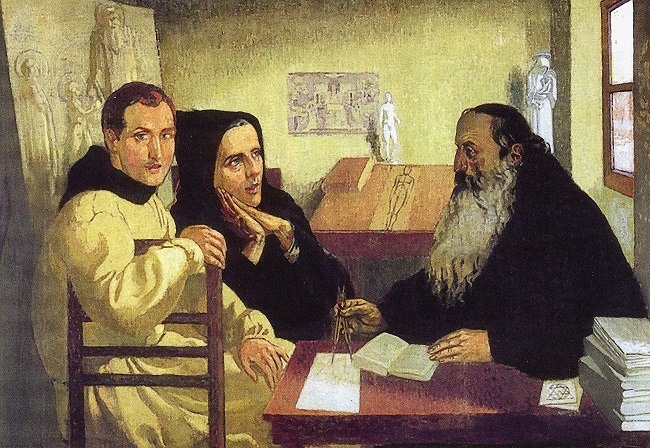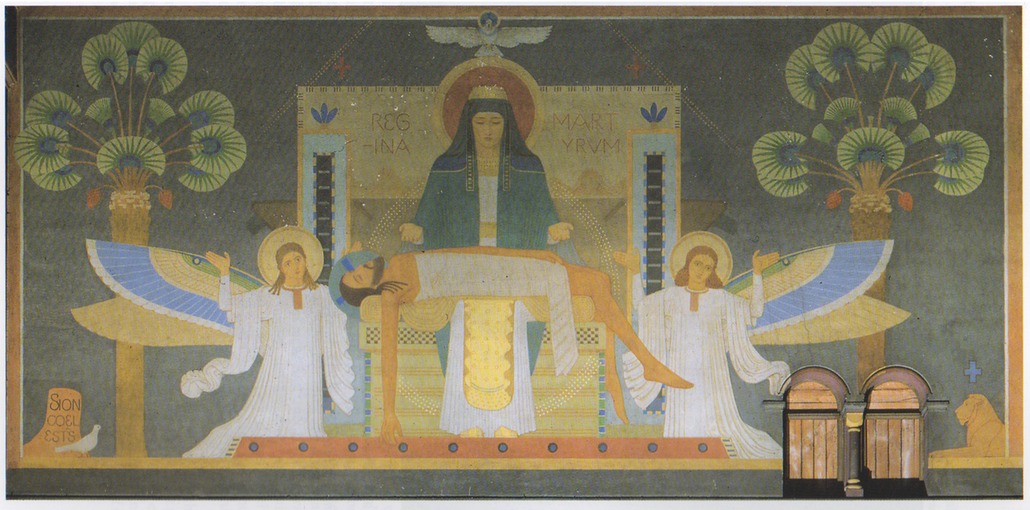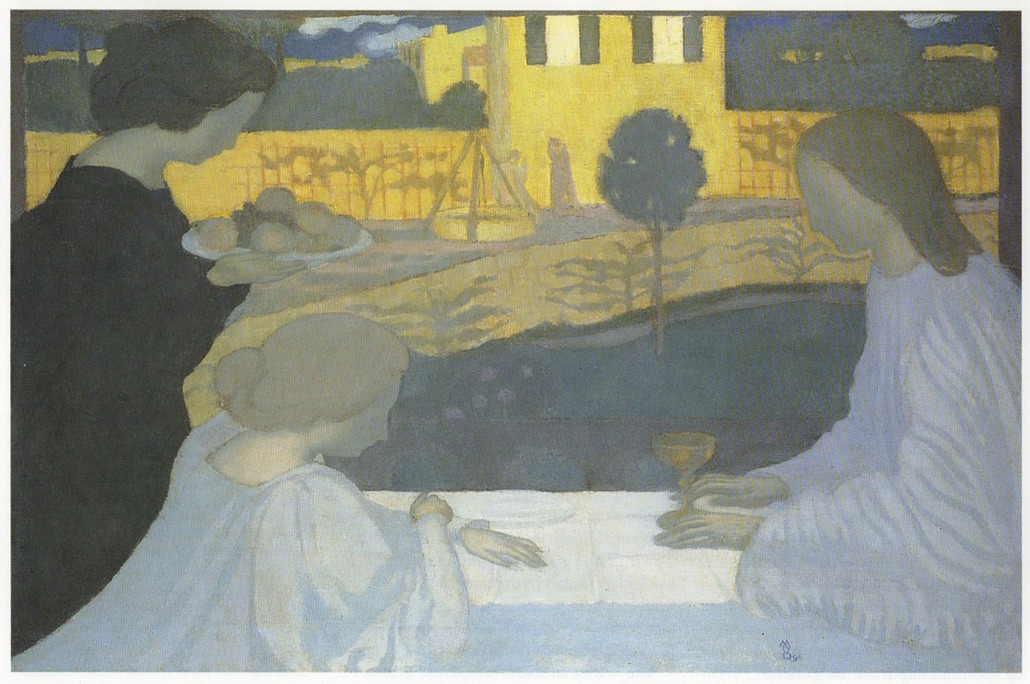HIERATIC ART - THE BEURON SCHOOL
The essay on Symbolism was written in 1918 at the end of the war, at a time when Denis was anxious to dissociate himself from any suggestion of German influence. In the 1890s, however, the period when Henry's influence was at its height, Denis, and more importantly Sérusier, were deeply interested in the 'technical and aesthetic norms' being proposed in Germany by Desiderius (or Didier) Lenz, German Benedictine monk, founder of the school of painting based in his monastery in Beuron in the Black Forest. (7)
(7) See Desiderius Lenz: The Aesthetic of Beuron and other writings, Introduction, translation, notes by Herbert Krins, John Minahane (misspelled Minihane in the book), John Connolly and Peter Brooke, London, Francis Boutle Publishers, 2002. See also the essay by Francesco Mazzaferro, Ten things we learned on Jan Verkade, accessible at http://malakim.cz/jan-verkade/
They had been introduced to the Beuron school by Jan Verkade, a young Dutchman, son of a successful manufacturer of biscuits (the brand name is still with us), who had come to Brittany to work with Sérusier, had been converted to Roman Catholicism then entered the Beuron monastery as a monk, under the name Willibrord. Sérusier soon proclaimed himself to be as much a disciple of Lenz as of Gauguin. Both Sérusier and Denis visited the different places in which the Beuron monks were working - Prague, Monte Cassino (St Benedict's monastery in Italy) and Beuron itself. Denis painted a beautiful (though very naturalist) picture of two young monks being taught by Lenz, Sérusier translated Lenz's theoretical statement The Aesthetic of Beuron and published it in 1905, with an introduction by Denis. Much later, Denis revealed the full scope of Sérusier's and his own interest in Beuron in his Life and Work of Sérusier, published, under the German occupation, in 1942, shortly before his own death.

Maurice Denis: Fr Desiderius with young monks, 1904
His essay of 1896, Notes on religious painting, is dedicated to Verkade. In it he distinguishes two types of religious painting:
'The one is, if I dare say so, an art of feeling [sentimentale], restoring the beauty of attitudes of prayer, of heads inclined in ecstasy, of kneeling, purity, naïveté of veiled young girls ...
'The other is less inspired by life and, in order to realise the absolute, turns to the intimate secret of nature - to number ... Think of the Egyptians, of the Byzantine mosaics in Italy, of Cimabue.'
Lenz's aesthetic theory was based on number and he argued that this mathematically based had found its earliest and highest known expression in Egypt.

Painting on the west wall of the Abbey Church of St Gabriel, Prague, done under the direction of Fr Desiderius, c1898

Martha and Mary by Maurice Denis, 1896
Denis' own inclination was clearly toward the art of feeling - 'the feminine manifestation of Catholicism'. And it has to be admitted that Sérusier's own efforts at a mathematically rigorous art were often less than successful. Even Verkade began to chafe at the discipline Lenz was proposing. Nonetheless in 1896, Denis seems to feel that, even if he himself is not yet ready for it, this is the way forward: 'I think also of you, Jan, who have found happiness in that German monastery where you consecrate your life and your art to the cult of restoring that Christian tradition that has been forgotten since the Renaissance.'
After evoking the art that has returned 'to the intimate secret of nature - to number', he invites us to 'note the evident similarity between those ideas and that which was once called symbolism' which 'was truly a light for minds overwhelmed by naturalism but at the same time too much taken by painting to surrender to the daydreams of idealism.' And he offers a very eirenic interpretation of symbolism, wanting to incorporate the rival Neo-Impressionists, insisting that in its origins this art was not 'mystical':
'It was certainly not an idealist theory. An immediate consequence of the positivist philosophies then in vogue and of the inductive methods which we held in such esteem, it was in truth the most strictly scientific of artistic endeavours. Those who launched it were landscape painters, still-life painters, not "painters of the soul" at all (influence of Cézanne upon Gauguin, Bernard etc.) They were minds passionate about truth, living in communion with nature and, I am quite sure, without metaphysical ideas. If they were led to "deform", to compose and finally to invent surprising formulas, it is because they wished to submit to the laws of harmony which determine the correspondence of colours, the organisation of lines (the researches of Seurat, Bernard, C.Pissarro): but also to bring a greater sincerity to the rendering of their sensations. Given the structure of the eye and its physiology, the mechanism of association and the laws of sensibility (insofar as we can yet know them) [this is Charles Henry's territory - PB] they drew from them the law of the work of art and immediately, by conforming to them, they obtained a more intense expression. from then on, instead of searching, ever in vain, to recreate their sensations just as they are [as the Impressionists had tried to do - PB], they applied themselves to finding their equivalents [ie the Neo-Impressionists, Seurat and Pissarro, like the Neo-traditionalists, became Symbolists - PB].
'Symbolism, idealism, naturalism are the three states of the esthetic.'
Naturalism has already, in the Definition of Neo-Traditionalism, been identified as the enemy. By idealism he means the Greek classical effort, mainly expressed in sculpture, to produce the Platonic idea of the natural form - the human form in the perfection of beauty. It happens, though Denis would not yet have known it, that this corresponds rather closely to Lenz's teaching - that by understanding the geometrical underpinning of the object, in particular the human form, the idea of it in the mind of God, the original Adam and Eve, can be uncovered. 'Symbolism' is, here and throughout his life, the term Denis prefers for his own art. In 1896 he is identifying it with 'Byzantine' art which he sees being renewed in the mathematically based, hieratic art of Beuron: 'Byzantine painting is assuredly the most perfect type of Christian painting.'
In this context he offers an interesting variation on the first proposition of the Definition of Neo-Traditionalism: 'a beautiful painting is before all else a flat surface covered with beautiful colours assembled in rhythmic forms.' We are very close to the definition proposed by Albert Gleizes in his Painting and its Laws (1922): 'To paint is to give life to a flat surface; to give life to a flat surface is to turn its space into rhythm [c'est en rythmer l'espace].'
Denis continues with an argument that might be less well adapted to pleasing the Neo-Impressionists:
'Once again, in our century so preoccupied with the Divine, a reaction of the religious spirit corresponds in painting to a recovery of the Byzantine idea. Our painters such as Puvis de Chavannes or, above all, Odilon Redon (to mention only masters inspired by Christianity) acted not only on the intelligence but also on the conscience of their time. In restoring to painting by force of audacity and genius the logic of its essential laws, they have reconnected with the Christian tradition. They have (as Verkade has said, speaking of the Byzantines) "imitated the Creator who has made all things according to measure, number and weight, who is Himself absolute order."
'Shall we ever find, as several have attempted, the laws, measures and techniques of the Byzantines and, even more so, the Egyptians? Will it be by experimentation, by the science of dynamogenics [a technical term used by Henry - PB], by calculation or by studying the Masters, or by mysterious formulas preserved in the library of a cloister?'
Most remarkably in the light of what we will see as the subsequent development of Denis' thought, he sees Giotto and the influence of Franciscan spirituality as the, albeit very attractive, beginnings of the slippery slope that passed from the high achievement of Byzantine art to the 'conquest of nature' and the eventual collapse into 'the triumph of academic convention, of pathos-filled trompe l'oeil, of a naturalism at once theatrical and pietistic.'